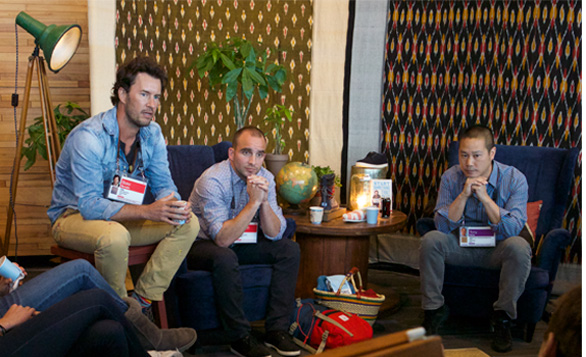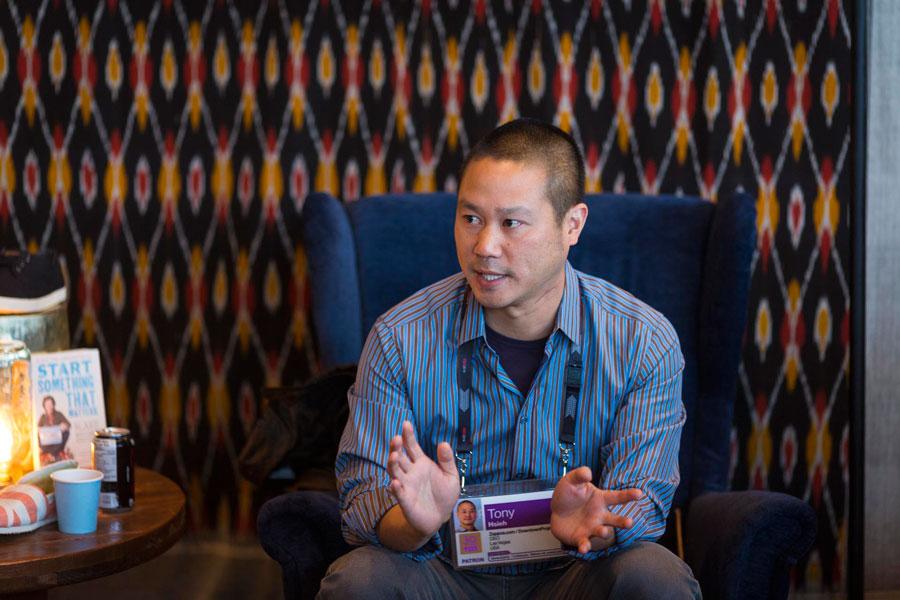
Heads of TOMS, GOOD and Zappos talk social good at TED2014. Photo: Bret Hartman
This afternoon, over a cup of coffee at the #TOMSRoastingCo Cafe at TED2014, the TED Blog listened in on a fascinating coffee-hour chat among three social entrepreneurs: Blake Mycoskie, founder of TOMS and the moderator of the conversation; Ben Goldhirsh, founder of GOOD, the online magazine and community; and Tony Hsieh, CEO of Zappos. Wait — Zappos? But as the conversation unfolded, it was clear that the shoe-shipping giant is as socially minded as TOMS and GOOD — and like them, is pursuing big social goals in ways that bring back benefit to the bottom line as well, keying off the company’s bold investment in downtown Las Vegas. Notes from their conversation:
Over a cup of coffee, Blake asked Tony and Ben, How do you measure success? Ben answered first: “I’m sometimes frustrated about the delta between where GOOD is at and the measure of success. Should our success be based on P&L or based on other goals? How do we measure those?” He continued: “I was just listening to JR talk about how art should be about failing, that artists have to be able to fail where a company can’t.” Here he laughs: “We’ve certainly treated our business like art.”
Tony took up the thread, “A great brand is a story that never stops unfolding. For me, I’m still with Zappos, after 15 years, because there’s always something new and unfolding. At first it was shoes, then customer service. We just moved into the former City Hall in downtown Las Vegas, and now we’re adding a whole community effort to it. There’s no company out there that owns the concept of community, and that’s where we’re headed.” Intriguing. He continues … “If you say ‘Zappos’ to a random person, they might say they know about our customer service or our company culture. ‘Community’ is the next phase of what Zappos means.”
Blake asked: How will that new focus change the customer experience?
Tony smiled and said: “The short answer is, we don’t know. But what we want to do is weave community into our customers’ experience. As an example, we had a skateboard event downtown. It was free to the community and employees, but we also livestreamed it to our customers who were interested in skate shoes. Or, we just did a fundraiser for a local zoo that was about to go out of business. We brought 70 or 80 animals, from kangaroos to lemurs, to the campus, and invited people from the community. Seven or eight thousand people came and made a donation, and we raised $250,000 for the zoo.”
“Does the Downtown Project live on the Zappo’s P&L?” asked Blake.
“No,” Tony said. “It’s funded by myself and a few other friends. We’re investing $350 million in downtown Las Vegas. There’s $50 million we’re investing in small businesses that make a city a good place to be — in restaurants, cafés, bars and so on. There’s $50 million set aside for tech companies through the VegasTech Fund. We’re investing $50 million into arts, education, music. And then $200 million in real estate.”
The project is rooted in practicality, he admits: “We wanted our employees to live, work and play in walking distance.” But there’s a bigger point to building a city around a company; he points to research that suggests “every time the size of the city doubles, innovation increases by 15%. But when a company doubles in size, innovation goes down. We want to be organized like a city, not a corporation.”
Ben echoes the point: “Our company is about tapping community DNA. In the early days, we’d have real block parties, people would meet husbands and wives, people were drawn together by common values. But after the party, our staff would be the only ones who could go home and turn this energy into work, into a magazine.” It was clear to him that the future of GOOD involved growing communities. (Shades of TEDx!) “GOOD started seeding local chapters where people are getting together in person, and it has grown to the point that we’re actually separating the environments in May. Community is the dominant reality for us now.”
Tony plays off that: “I wasn’t interested in urban planning 15 years ago, but I used to throw a lot of parties. Say there’s two bars at a party; people are going to cluster at the bar in the front and ignore the one in the back. So I used to only open the bar in the back at first, let people find it, and then open the front bar two hours later. I love parties where people move around and meet. I have this pet peeve about dinner parties, where you’re stuck next to the same two people for three hours. It’s the same thing at a city level. When you’re in a semipublic place, you can serendipitously run into someone, and something great could happen. So when we plan, we have metrics called collisions. We’re going for 100,000 collisionable hours per acre per year, or 2.3 collisionable hours per square foot. It’s less about urban planning and more about throwing a good party.”
The question comes up: What’s more challenging: driving social impact or the bottom line? Blake answers: “We set ourselves up as a giving business, and we wanted to prove that One for One could work. In the earliest days of TOMS, the challenge was sales. I was selling shoes out of my Airstream and just working so hard to grow sales. But once sales started to take off, we turned our energy on the impact of our giving. Then we turned to focus back on sales. You move back and forth.”
Ben agrees, “It’s a tough metric. Great companies have a higher purpose, which ironically enables more profits.”
As Blake says, “Our giving is also our marketing. And it also adds to employee happiness and retention.” This is an important point that draws nods from all three speakers: Employees respond to a company with a mission that inspires them. As Blake concludes: “Tackle the inspiration part, and retention takes care of itself.”

Tony Hsieh of Zappos speaks at #TOMSRoastingCo Cafe at TED2014. Photo: Bret Hartman
Comments (2)